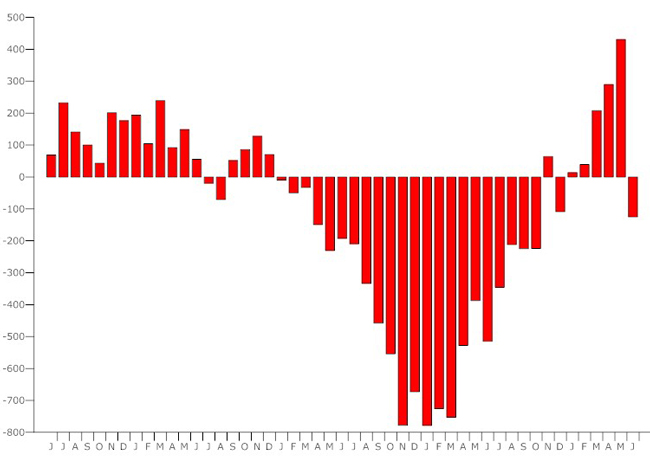
With 225,000 temporary Census 2010 workers no longer on the payroll, spring’s national employment bump vanished, the private sector remains too weak to compensate, and the economy as a whole lost 125,000 jobs in May, leaving a total of 14.6 million Americans (7.5 percent of them in Florida) unemployed.
Click On:
- May: Census Jobs Help Lower Unemployment; Flagler at 15.1%, Florida at 11.7%
- Complete May 2010 Florida Unemployment Report
- April: Flagler Unemployment Lowest in a Year
- April: National Job Creation Soars by 290,000, Unemployment at 9.9%
- March: At 16.6%, Flagler Unemployment Crawls Lower
- March: US Economy Adds 162,000 Jobs, 1st Increase Since 2007
- January: 16.9% Unemployment in Flagler, 11.6% in Fla.
- Franklin D. Roosevelt’s Second Bill of Rights: For Workers
- Where and how to file for unemployment
Almost half the unemployed, or 6.8 million, have been without work for 27 weeks or more. And 8.6 million Americans are working part-time either because their hours have been cut back or because they’ve been unable to find full-time work. In addition, 2.6 million unemployed workers were not counted as part of the total unemployment pool because they had not looked for work in the past four weeks (but had done so in the past 12 months). Those are the people the Labor Department considers “marginally attached” to the workforce–people willing to work, but too discouraged to look assiduously for work. That category has grown by 414,000 workers in the past 12 months, an indication of a worsening economy, not an improving one.
In sum, between part-timers and the discouraged, the unemployment rate is severely under-reporting the true effects of a weak employment picture in the nation.
In Flagler County in May, the unemployment rate had fallen to 15.1 percent, lowest in a year, helped here, too, by hundreds of census jobs. Some 32,100 government jobs were added to Florida payrolls in May. But federal numbers released today are one month ahead of state numbers. Florida’s June and July unemployment numbers will be more indicative of the direction of the economy, as the skewed effects of temporary census jobs will have mostly disappeared by then.
Nationally, the private sector did add 83,000 jobs, but for the economy to stay even, with new entrants in the labor force, it must create between 110,000 and 125,000 jobs a month, and to grow, it must add well above those numbers. The Labor Department points to 600,000 private sector jobs created in the first six months, an average of 100,000 a month–barely under the break-even point, but significantly below the rate of an economy bouncing out of recession, when job creation is usually very strong. That wasn’t the case after the 2001 recession. It is still not the case after the last recession, the most severe on record since the Depression of the 1930s. And despite the 600,000 private-sector jobs created since January, the economy is still 7.9 million private sector jobs below the December 2007 level.
Worse news for job-seekers: the federal economic stimulus is beginning to run out, and the federal government, along with state and local governments, are reducing spending considerably.
Here’s where the jobs were created:
Temporary help in professional services added 21,000 jobs, for a total of 379,000 new such jobs since September 2009. Temporary jobs are not high-quality and carry no benefits for the employee. Management
and technical consulting and business support services saw an increase of 18,000 jobs. Transportation and warehousing added 15,000 jobs. Health care employment, usually stronger, added a mere 9,000 jobs, with a total of 217,000 added over the past 12 months. Mining added 6,000 jobs, and manufacturing added 9,000, for a total of 136,000 new manufacturing jobs since December 2009.
But construction employment continues to fall (22,000 jobs lost in June). Government jobs fell by 208,000, driven largely by census job losses. State and local governments have not been adding or losing jobs.
And in one last bleak spot for workers, average hourly earnings of all employees in the private sector
decreased by 2 cents, or 0.1 percent, to $22.53 in June. Over the past 12 months, average hourly earnings have increased by 1.7 percent. In June, average hourly earnings of private-sector production and non-
supervisory employees were unchanged at $19.00.





























Leave a Reply